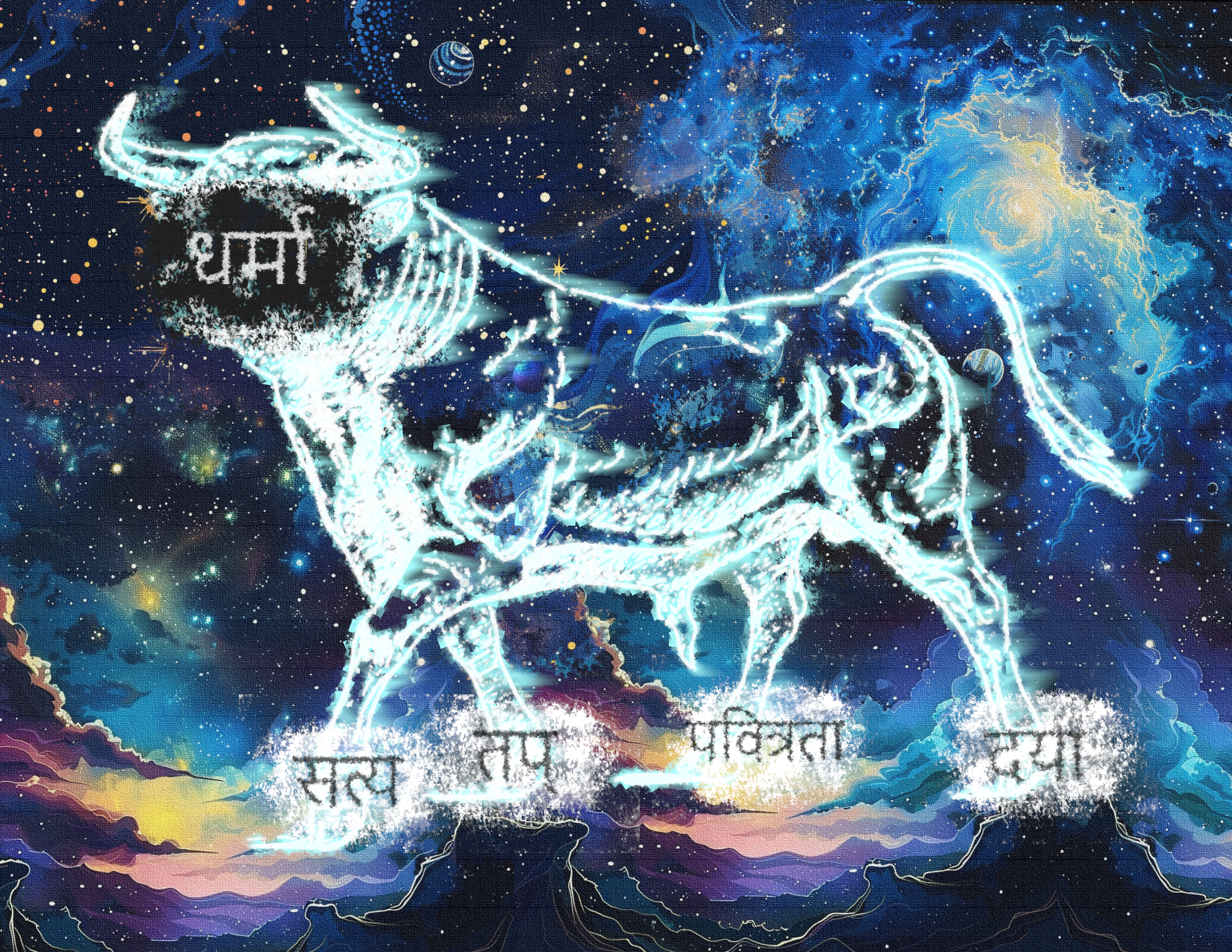Dharma
Gallery | Links:

धर्म (Dharma) is sometimes defined as “duty” or “law”. However, this definition of the Sanskrit word doesn’t fully capture the true meaning of the word. Dharma is much deeper than just a job description. It’s quite literally “our essence”. For example, the dharma of sugarcane is “sweetness”. Everyone’s dharma is unique and manifests into behavior by intellect through training. It refers to the roles we are each uniquely positioned to fulfill, such as being a father, employee, or student.
In the Srimad Bhagavatam, dharma is described as a bull who stands on the following four legs:
तप् (Austerity) - emphasizes hard work and self-discipline for long-term gains over short-term pleasures, recognizing the Atman (eternal Self). It underscores the importance of willpower and the belief in the soul’s eternity to overcome short-term temptations, aiming for eternal happiness. Austerity’s essence lies in the disciplined sacrifice of short-term pleasures for significant, lasting achievements, highlighting its role as a foundational principle for moral and spiritual development. This practice fosters mastery over physical and mental urges, aligning actions with dharma’s long-term vision.
पवित्रता (Purity) - extends beyond physical hygiene to encompass systematic and organized living and working. It advocates for a disciplined approach to tasks, prioritizing long-term benefits over short-term gains, to avoid the pitfalls of disorder and inefficiency. This principle highlights the importance of patience and perseverance in achieving reliable outcomes and maintaining moral and spiritual purity. Cleanliness symbolizes a methodical progress that ultimately outpaces sporadic efforts, embodying the belief in sustained, meaningful achievement over fleeting satisfaction.
दया (Kindness) - contrasts directly with selfishness, advocating for unselfish, cooperative behavior rooted in self-confidence and humility. It highlights the destructive cycle where selfishness undermines trust and leads to isolation. Kindness is presented as both an emotional strength and a moral duty, emphasizing the importance of overcoming one’s flaws to support and enhance the lives of others. True kindness fosters strong relationships based on mutual respect and trust, ultimately leading to a more generous and outward-looking form of charity that transcends mere ego.
सत्य (Truth) - emphasizes the importance of honest communication for the long-term betterment over superficial kindness or immediate gratification. It argues for the value of truth, even when harsh, as a means to encourage discipline, correct flaws, and promote genuine well-being, challenging both the speaker and listener to embrace discomfort for greater moral and spiritual growth. This leg underlines the necessity of detachment and unbiased perception in recognizing and living by truth, making it a vital component of ethical and fulfilling relationships.
The four legs of dharma—Austerity, Purity, Kindness, and Truthfulness—align with the four yugas: Satya, Treta, Dvapara, and Kali, respectively. In each era, a particular virtue takes precedence, reflecting the societal and spiritual capacities and needs of the time. Austerity is emphasized in the Satya-yuga, a time of spiritual discipline and ascetic practices. Purity, symbolizing ritual purity and order, dominates the Treta-yuga. Kindness, focusing on benevolence and moral actions, is central to the Dvapara-yuga. In the Kali-yuga, Truthfulness becomes paramount, addressing the era’s challenges with honesty and integrity. Despite this, the general principle is that one must sincerely aim to maintain all four legs, and at the very least aspire to practice truthfulness. It is said that the highest form of अधर्म (adharma - an unjust act that disrupts the balance of nature) is self-deception, as it leads to the deception of others, and over time to unkindness and uncleanliness, succumbing to the pleasures of the body and mind, ultimately submitting to the illusion of existential reality, माया (maya).
